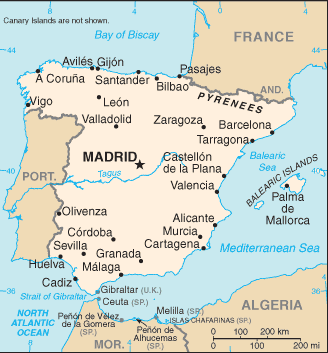Map:

Overview:
Spain's powerful world empire of the 16th and 17th centuries ultimately yielded command of the seas to England. Subsequent failure to embrace the mercantile and industrial revolutions caused the country to fall behind Britain, France, and Germany in economic and political power. Spain remained neutral in World Wars I and II, but suffered through a devastating civil war (1936-39). In the second half of the 20th century, Spain has played a catch-up role in the western international community; it joined the EU in 1986. Continuing challenges include Basque Fatherland and Liberty (ETA) terrorism and further reductions in unemployment.
The People:
Population: 40,341,462 (July 2005 est.)
Age structure:
0-14 years: 14.4% (male 2,994,124/female 2,815,456)
15-64 years: 68% (male 13,762,281/female 13,664,762)
65 years and over: 17.6% (male 2,965,859/female 4,138,980) (2005 est.)
Religions:
Roman Catholic 94%, other 6%
Government Type:
parliamentary monarchy
Leader(s) to pray for:
chief of state: King JUAN CARLOS I (since 22 November 1975); Heir Apparent Prince FELIPE, son of the monarch, born 30 January 1968
head of government: President of the Government and Prime Minister Jose Luis RODRIGUEZ ZAPATERO (since 17 April 2004); First Vice President and Deputy Prime Minister (and Minister of the Presidency) Maria Teresa FERNANDEZ DE LA VEGA (since 18 April 2004) and Second Vice President (and Minister of Economy and Finance) Pedro SOLBES (since 18 April 2004)
Source: The World Factbook
View All Countries